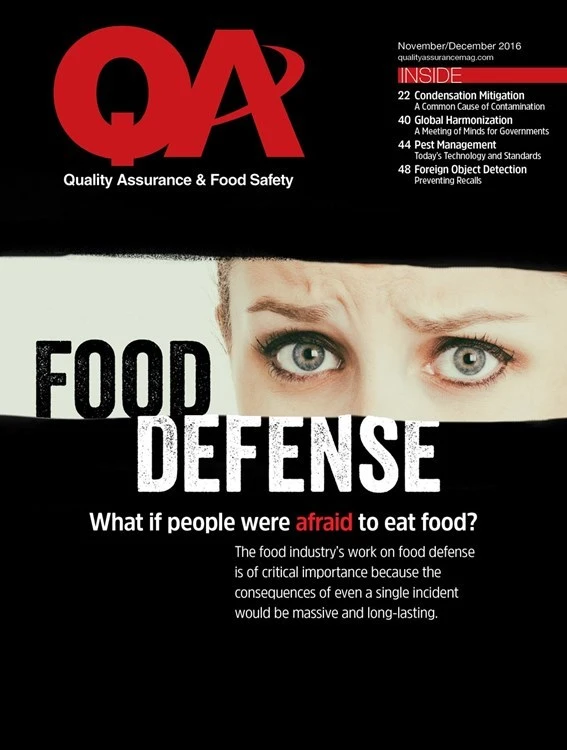
By Manuel Orozco
A. A master cleaning schedule includes cleaning of equipment, tools, containers, structures, and grounds, and identifies the area or equipment to be cleaned, the time period between each cleaning, and the person(s) responsible for the cleaning. As it is completed, it also becomes a work record. Cleaning can be scheduled for several months in advance or for an entire year. To be workable, the master cleaning schedule must be drawn up realistically. Available manpower, production schedules, and special types of equipment needed should be considered. Such a schedule should serve as a reminder of when the jobs are due to be done and as a checklist of job completion. Although sanitation/hygiene principles are constant, application details will vary from plant to plant.
Equipment, floors, drains, and walls may be identified as potential hazards since bacteria may establish on these surfaces and can contaminate food products. The identified sanitation control to keep the hazard from happening would call for equipment, floors, drains, and walls to be cleaned and sanitized on a predetermined schedule.
As a primary record of the sanitation program (with the daily cleaning schedule, cleaning procedures, chemical concentration checks, post-cleaning and pre-operational inspections, cleaning validation, and training), the master cleaning schedule is designed to track required and completed cleaning that occurs less often than daily.
Maintaining a sanitary environment is essential to the success of any food company. Food companies and commercial food establishments must comply with the highest standards of sanitation enforced by various government agencies, such as GMPs and those of FDA, OSHA, USDA and other food regulatory agencies throughout the world.
Your HACCP program can be used in one form or another to establish a sanitation program. It involves a detailed analysis of the manufacturing flow beginning with the receipt of raw materials or processed ingredients. This analysis begins with the identification of product risks or product sensitivities as they relate to consumer safety and acceptance. Once the risks are identified, each piece of equipment in the flow is studied to determine its potential contribution to the identified risks. A sanitation control is then set up to prevent the determined potential hazards from developing.
Common frequencies for tasks in a master cleaning schedule are semi-weekly, weekly, bi-weekly, semi-monthly, monthly, bi-monthly, quarterly, semi-annually, annually, and per hours of use.
“As needed” is not a valid frequency to be listed. In these instances, the frequency listed should be that at which the area or equipment is to be checked to see if it needs cleaning. If it is checked and cleaning is not required, a note to this effect can be made on the schedule.
To create a master cleaning schedule, cleaning frequencies must be defined as tasks. When first developed, appropriate frequencies may not be known. In these instances, an estimate should be made, which then may be adjusted, to greater or lesser frequency using results from the environmental monitoring and integrated pest management programs to validate frequencies.
It is also possible that frequencies for some tasks will be different based on the season. For example, warmer and more humid months may require more frequent cleaning of flour silos to control mold and insect issues. Cleaning frequencies must be adjusted to the particular needs of the individual plant.
A common pitfall in the development of master cleaning schedules is the listing of too large of an area as a single task. For example, in most facilities, it would be impractical to expect all warehouse racking to be cleaned at one time. Therefore, warehouse racking should not be listed as a single task. A more manageable approach would be to divide the racking into zones and assign each zone as an individual task. Another instance in which a task may need to be divided is if the entire area is not accessible at the same time. An example of this is cleaning under the dock plates. From a time perspective, it may be very reasonable to clean under all dock plates at one time, however, not all docks may be accessible at the same time due to vehicle traffic.
The sign-off on the master cleaning schedule must be provided for each completed task. The signature/initials may be that of the person who completed the task or the person who confirmed that the task was completed, such as a supervisor or lead person. Master cleaning schedules also depend on visual inspection or chemical measurements, like ATP and food allergen testing at strategic control points to assure that the in-place sanitation program works.
As the master cleaning schedule becomes a primary record in a sanitation program, it becomes fundamental evidence to prove that the program has been followed.
Manuel Orozco, AIB Food Safety Professional.
Explore the December 2016 Issue
Check out more from this issue and find your next story to read.
Latest from Quality Assurance & Food Safety
- AFDO Webinar Series Offers Strategies for Difficult Times
- FDA, USDA Rehire Some Staff, Multiple Sources Report
- Nestlé Opens Arizona Beverage Factory and Distribution Center
- Ingredion Invests $100 Million in Indianapolis Plant to Improve Efficiency, Enable Texture Solutions Growth
- Eagle Unveils Redesigned Pipeline X-ray System
- USDA Invests Up To $1 Billion to Combat Avian Flu, Reduce Egg Prices
- Washington Cats Confirmed with HPAI as Investigation into Contaminated Pet Food Continues
- USDA Confirms Bird Flu Detected in Rats in Riverside





